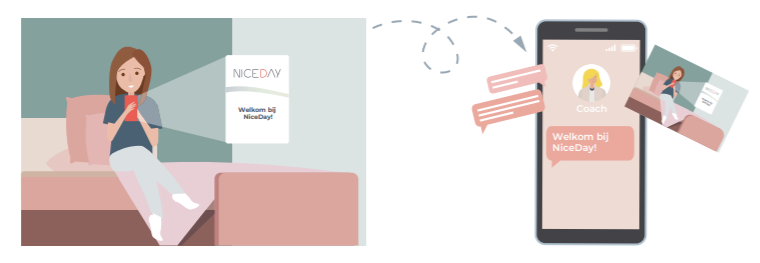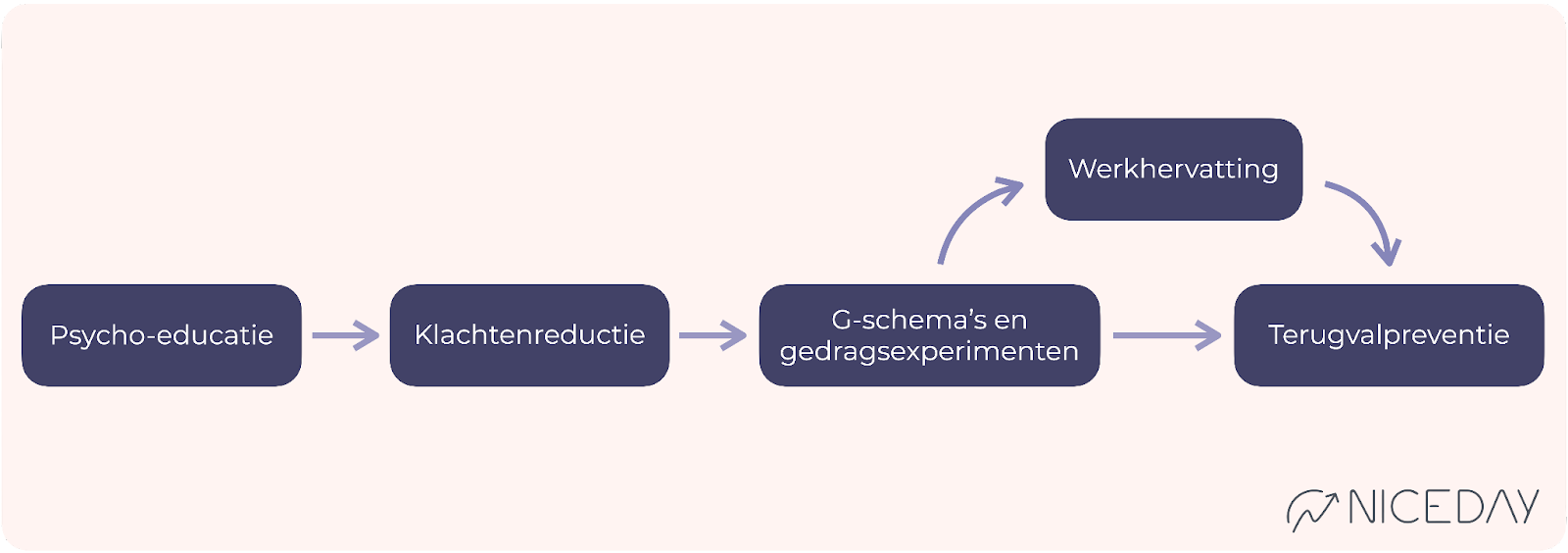Burn out Protocol
This protocol for burnout is composed of core interventions. It can be conducted online or in a blended format and is based on existing protocols, scientific sources, and mental healthcare standards, utilizing NiceDay. Within this treatment, the emphasis is placed on strengths, building trust, and encouraging an active work attitude. Additionally, it facilitates autonomy through encouragement and motivation, shared decision-making, and involving loved ones. Depending on your client's personal situation and complaints, you can employ supportive articles, with inspiration provided at the end of the protocol.
This protocol provides therapists with guidance and inspiration regarding the possibilities within NiceDay. It consists of core interventions that can be utilized based on the therapist's assessment. The protocol does not need to be strictly followed; instead, it can be tailored to align with the client's situation and complaints.
Core interventions
The CBT treatment for burnout consists of the following core interventions:
📖 Psycho-education
📈 Reduction of complaints
🧪 Thought records and behavioural experiments
💼 Work resumption (optional)
🔁 Relapse prevention
Other possible interventions:
- In consultation, pharmacological therapy can be used as an adjunct to CBT treatment.
- Mindfulness
The order
The treatment begins with psycho-education about burnout and CBT. After identifying the symptoms, the focus is on symptom reduction. Cognitive therapy can then be initiated. Subsequently, an additional module for work resumption and work-focused interventions may be chosen. The treatment concludes with relapse prevention.
The pace and frequency
Depending on the severity of the symptoms, the effectiveness of the therapy, and the decision to include work resumption or not, the duration of the treatment can be estimated to be around 10 to 14 sessions. It is advisable to schedule frequent sessions at the beginning of the treatment. In terms of managing expectations, it is important to make agreements with your client about the duration of the treatment.
Outcome Feedback (OMQ and SMQ)
To monitor progress effectively, you can use two short (5-question) questionnaires that are administered around each session. Prior to each session, the Outcome Measurement Questionnaire (OMQ) assesses the severity of the symptoms. After each session, the Session Measurement Questionnaire (SMQ) evaluates the quality of the treatment session and the working relationship. You can find the manual here. If necessary, discuss the results with your client.
Flexible Time
Flexible time refers to the time you spend with your client outside of the sessions (e.g., chatting, sending psychoeducation, or writing session notes). This allows you to stay engaged with your client and monitor progress effectively. You can assess how much time is needed per client. If you need more inspiration for what you can do, refer to this article.
Within the flexible time, there are several standard actions per session:
|
Involving Social network
Discuss with your client whether and how their social network can be involved in the treatment process. The client's environment can both facilitate and unintentionally hinder the treatment process by maintaining avoidance and safety behaviours. You can find information on how to involve the social network in the treatment process here.

📖 Core intervention: Psycho-education.
The goal of Psycho-education is to provide your client with information about social anxiety and prepare them for one of the core interventions by initiating symptom monitoring. This typically takes about 1-2 sessions on average.
Deepening core intervention psycho-education
Flexible time - prior to the first session: 5 minutes Welcome message
Psychoeducation
|
Session (1 of 2 sessions): 35 minutes
What can I do for you?
- Explain outcome feedback (the OMQ and SMQ)
- Discuss the psychoeducation and check if there are any questions.
- Discuss the treatment goal together with the client.
- Discuss whether the social network can be involved in the treatment.
- Together, set realistic and achievable treatment goals and establish crisis plans if necessary. If there is a presence of suicidality, it is important to monitor this on a weekly basis.
- Discuss the purpose of symptom tracking and begin to track symptoms.
Use trackers such as Tension or Fatigue or Energy
or choose another relevant tracker, like: Overstimulated or Cognitive complaints or Assertiveness or Rest & relax
It is preferred to have your client track symptoms as frequently as their capacity allows. (Tip: set reminders!) - Schedule the next session in consultation with the client. Optionally, plan ahead if desired. Activate the OMQ and SMQ.
- Provide examples of exercises and assignments for the client to practice at home:
- Complete the symptom registration and fill in the activated trackers as discussed.
- Discuss with the client if they would like to take session notes and explain how they can do so.
- Encourage the client to read the sent psychoeducation materials if they haven't done so already.
- Ask your client to fill out the SMQ after the session.
- Ask your client to create a timeline of the progression of their burnout symptoms and relevant events.
Flexible time 15 minutes How can you allocate this time throughout the week?
|
📈 Core intervention: Symptom reduction
The goal of Symptom Reduction is to promote physical recovery. Through symptom monitoring, you identify the relevant symptoms and then work together to devise practical solutions to prevent or reduce these symptoms. On average, you dedicate at least 3 sessions to this process, but it may be relevant to continue monitoring throughout the entire treatment.
Deepening core intervention: Symptom reduction
Flexible time - prior to the first session: 5 minutes. What can you do?
|
Session 1: 35 min
- Discuss the symptom registration and go over the past few days.
- Create a daily schedule together with your client. Discuss the importance of a well-structured day and engaging in meaningful and enjoyable activities.
- Emphasize the importance of a healthy lifestyle. Discuss lifestyle changes if they are relevant to the client.
- Introduce relaxation exercises. Encourage the client to practice them as frequently as possible..
- Examples of exercises and assignments to do at home:
- Continue with symptom registration using the trackers.
- Go over the list of enjoyable activities if necessary.
- Agree on specific times to engage in relaxation exercises. Set reminders to help prompt the client to do them.
- Encourage the client to read the sent psychoeducation materials if they haven't done so already.
- Ask your client to fill out the SMQ after the session.
Flexible time 15 minutes
|
Session 2: 35 min
- Follow up on the symptom registration and review the past few days with the client.
- Discuss the changes in daily structure and lifestyle and expand them if possible. Focus particularly on activities that provide energy and those that drain energy.
- Examples of exercises and assignments to do at home:
- Continue with complaint registration and fill in the activated Trackers as discussed.
- Continue with relaxation exercises.
Flexible time 15 min
|
Flexible time: 15 minutes.
- Follow up on the ongoing symptom registration and discuss any changes in the daily structure.
- Explain the purpose of the self-monitoring program to recognize the signs of overload and prevent complaints from building up. Then devise self-monitoring measures.
- Examples of exercises and assignments to do at home:
- Continue with symptom registration and fill in the activated trackers as discussed.
- Continue with relaxation exercises.
- Monitor self-control signals and measures.
Flexible time: 15 minutes.
|

🧪 Core intervention: Thought records & Behavioural Experiments
The goal of Thought Records and Behavioural Experiments is to examine and test the impact of unhelpful thoughts on unwanted emotions or behaviours, and evaluate them based on reality. You identify and challenge unhelpful thoughts using Thought Records, and design behavioural experiments to practice new behaviours. On average, this process takes at least 6 sessions.
Deepening core intervention thought record
Deepening core intervention behavioural experiment
Flexible time - before the first session: 5 minutes.
|
Session 1: 35 mins
- Explain the purpose of Cognitive Therapy and pay extra attention to the role of lifestyle rules.
- If desired, fill in the Cognitive Model together.
- Fill in step 1 of the Thought record together.
- Monitor the continuation of symptom registration.
- Examples of exercises and assignments for home:
- Fill in step 1 of the Thought record daily. Set a reminder for it.
- Fill in step 1 of the Thought record daily. Set a reminder for it.
Flexible time 20 min
|
Session 2: 35 mins
- Discuss the homework and monitor whether the client understands everything. Provide additional explanations about feelings, thoughts, and behaviours if necessary.
- Review Step 1 of the completed Thought records together and explore core beliefs and lifestyle rules underlying unhelpful thoughts. You can use techniques like the "downward arrow technique" to delve deeper into underlying beliefs.
- Then, together with your client, fill in the subsequent steps 2 and 3 of the Thought record.
- Monitor the continuation of symptom registration.
- Examples of exercises and assignments for home:
- Fill out a Thought record daily. Set a reminder for it.
- Practice challenging unhelpful thoughts.
- Practice formulating helpful thoughts.
Flexible time 20 min
|
Sessie 3: 35 min
- Discuss the homework and monitor whether the client understands everything.
- Review the completed Thought records (steps 1 to 3) and discuss unhelpful and helpful thoughts or lifestyle rules.
- Provide support, if necessary, in formulating helpful thoughts. You can also utilize other cognitive techniques for this purpose.
- Discuss any possible thinking styles that may be present together.
- Monitor the continuation of symptom registration.
- Examples of exercises and assignments for home:
- Complete a Thought record daily, potentially with the help of a reminder.
- Practice challenging unhelpful thoughts and formulating helpful thoughts.
- Practice recalling or remembering helpful thoughts.
- Practice recognizing thinking patterns or cognitive styles.
Flexible time 20 min
|
Sessie 4: 35 min
- Create a list of all the helpful thoughts and have the client write them on a card to display in a prominent place, such as hanging it up somewhere visible..
- If necessary, utilize alternative challenging techniques or cognitive techniques such as Downward Arrow Technique, Multidimensional Evaluation, Pie Chart Technique, Cost-Benefit Analysis, Probability Calculations, Role-Playing, Flash or Coping Cards, Imagery, and Imagery Rescripting.
- Examples of exercises and assignments for home:
- Fill out a Thought record daily. Use a reminder if needed.
- Practice challenging thoughts and formulating helpful thoughts.
- If relevant, focus on creating helpful thoughts, core beliefs, and rules for living.
- Hang cards with helpful thoughts or set reminders with helpful thoughts in the app.
- Practice imagery after formulating helpful thoughts.
Flexible time 20 min
|
Before starting the implementation of behavioural experiments, it is important that the client is proficient in formulating helpful thoughts. The duration of this may vary for each client.
Session 5: 35 mins
- Discuss the homework assignments and encourage the client to continue filling out Thought records.
- Discuss the helpful thoughts and insights gained. Use the Thought record as a bridge to introduce behavioural experiments.
- Explain behavioural experiments and why it is important to practice alternative behaviours.
- Together, create the first behavioural experiment. For example, based on the question "What would you do differently based on this helpful thought?" Both of you can input this in the NiceDay app if available.
- Examples of exercises and assignments for home:
- Continue practicing steps 1 to 3 of the Thought record.
- Implement the behavioural experiment and note how it went.
- Ask the client to make session notes for this session.
Flexible time 20 min
|
Session 6 to completion 35 min
- Discuss how the first behaviour experiment went.
- Work together to come up with more experiments for the client to practice (ideally as many as possible). You can find examples of behaviour experiments and guidelines on how to formulate them in the Knowledge Base under the core intervention of Behavioural Experiments.
- Examples of exercises and assignments for home:
- Carry out the experiments and record them in NiceDay.
- Ask the client to make a session note about this session.
Flexible time 20 min
|
Evaluate
After 6 sessions, assess the effectiveness of the Thought records and behaviour experiments, as well as the insights gained. If the intervention is effective, continue until the new cognitions and behaviours are more or less "anchored," and the treatment goals are (largely) achieved. If you notice that therapy is not having sufficient effect despite the client's efforts and your own, discuss this with the client and in the multidisciplinary team meeting (MDO). Explore possible causes and make adjustments to the therapy if necessary.
💼 Core intervention Return to work
The core intervention Work Resumption aims to successfully help your client return to the job market. You investigate what your client needs and identify any potential obstacles. Step by step, you collaboratively devise practical solutions to facilitate your client's reintegration at an appropriate pace. On average, this process takes at least 4 sessions.
Deepening core intervention Resumption of work
Flexible time - 5 minutes before the first session on Work Resumption
|
Session 1: 35 mins
- Explain about resuming work.
- Together, fill in step 1 of the action plan: evaluate all tasks based on enjoyment, workload, time pressure, and dependence on others. Then determine which tasks your client will begin with when resuming work.
- Examples of exercises and assignments for home:
- Have your client discuss the action plan with their supervisor. The goal is to reach concrete agreements regarding the resumption of work.
- Have your client record all work-related events and accompanying stress in a daily diary.
Flexible time 20 min
|
Session 2: 35 mins
- Discuss the homework and monitor whether the client understands everything. Provide additional explanations if necessary.
- Monitor the continuation of complaint registration.
- Create an energy balance table together with your client.
- Create an overview of resources and obstacles together with your client.
- Discuss work events and explore potential obstacles. It is important to work together to find solutions.
- Examples of exercises and assignments for home:
- Ask your client to complete or update the tables on their own.
- Keep track of work events and obstacles.
Flexible time 20 min
|
Session 3: 35 mins
- Discuss the homework and monitor if the client understands everything.
- Monitor the persistence of complaints registration.
- Analyze the energy balance, resources, and obstacles. Explore possible solutions together.
- Discuss possibilities for job crafting and change strategies.
- Examples of exercises and assignments for home:
- Encourage the client to discuss potential desires for change with their supervisor.
- Implement the discussed change strategies.
Flexible time 20 min
|
Session 4: 35 mins
- Discuss the homework and monitor if the client understands everything.
- Monitor the continuation of complaint registration.
- Discuss applied change strategies.
- Discuss short and long-term goals related to work resumption.
- If your client struggles with time management and carrying out previous agreements, continue with the time management exercises.
- Examples of exercises and assignments for home:
- Have your client discuss the goals with their supervisor.
Flexible time: 20 min
|
🔁 Core intervention Relapse prevention
The goal of Relapse Prevention is to map out how someone can recognize and monitor potential relapse, identify their pitfalls, and provide them with tools to deal with symptoms or situations. This typically takes about 1-2 sessions.
Deepening core intervention relapse prevention
Flexible time - before the first session on relapse prevention 5 min
|
Session (1 or 2 sessions) 35 min
- Reflect on the progress of the Outcome Questionnaire (OMQ) and Session Monitoring Questionnaire (SMQ) and discuss any other questionnaires, if applicable.
- Evaluate the treatment:
- Discuss the effect of the treatment.
- Identify the obstacles that have been overcome and those that are still present.
- Predict and normalize: It is normal to experience anxiety again in situations that are currently not problematic. Stress, fatigue, and/or changes in your life can play a role in this.
- Create the relapse prevention plan together:
- Make a list of situations and problems where relapse into old behaviours may occur.
- Have your client write down a strategy for each situation that can be applied in those specific situations.
- Exercises and assignments for home:
- Encourage your client to continue applying everything they have learned. Remind them to keep using the app, such as filling out trackers to stay alert to the amount of rumination, avoidance, and safety behaviours, as well as using the Thought record to challenge unhelpful thoughts.
- Ask your client to make a session note of this session.
- Request your client to complete the relapse prevention plan.
Flexible time: 20 min
|
📚 Inserting articles
Based on your client's personal situation and complaints, you can use supporting blog articles. These are written by professionals and experts by experience and can be found on niceday.app. Think of:
- Personality and burnout
- How your energy bottles run out during a burnout
- Is your scale in balance?
- Do you recognize signs of stress?
- Are you aware of your health every day?
- Importance of a healthy lifestyle in psychological complaints
- Your reaction to stress, consciously or unconsciously
- Rules for living: helpful or limiting?
- Relaxation exercise 'Progressive Relaxation'
Sources
- Keijsers, G. P. J., Van Minnen, A., Verbraak, M., Hoogduin, C. A. L. & Emmelkamp, P., (2021). Protocollaire behandelingen voor volwassenen met psychische klachten.
- https://www.ggzstandaarden.nl/zorgstandaarden/aanpassingsstoornis-incl-overspanning-en-burn-out/samenvatting

